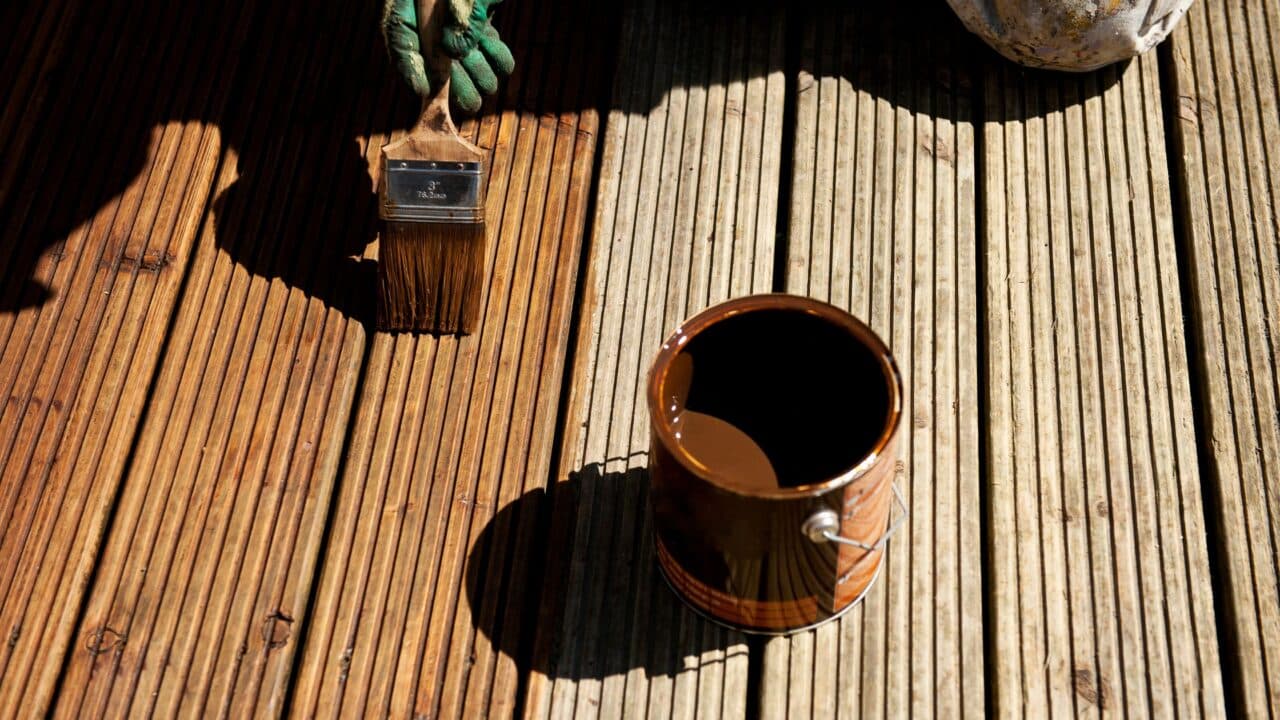Staining a deck after rain is possible — but only if the wood is completely dry. Most stains require 24–72 hours of dry weather before application, depending on temperature, humidity, and wood type. Staining too soon leads to poor adhesion, blotchy color, and premature peeling.
Can I Stain My Deck If It Just Rained Yesterday?
You’ve got a free weekend, your deck is prepped, and your stain is ready — but Mother Nature threw in a surprise storm the night before. So now you’re left wondering: Can I still stain my deck, or do I need to wait longer?
The short answer: Maybe — but probably not yet.
Staining after rain isn’t just about surface dryness. What matters is whether the wood itself has fully dried all the way through. Stain that traps moisture beneath it can peel, bubble, or fail within months.
In this article, we’ll cover:
-
How long to wait after rain before staining
-
How to tell if your deck is dry enough
-
What affects drying time
-
What happens if you stain too early
-
Pro tips for avoiding common mistakes
🕒 How Long Should You Wait to Stain a Deck After It Rains?
Most manufacturers and pros recommend waiting at least 24 to 48 hours after rain — but that’s a general guideline, not a guarantee.
Ideal drying time depends on:
-
Wood type: Softwoods (like pine or cedar) absorb and hold more water than hardwoods.
-
Humidity: High humidity slows evaporation.
-
Temperature: Cool days (under 60°F) significantly delay drying.
-
Sun exposure: Shaded decks dry much slower than full-sun areas.
-
Deck age and condition: Older, more porous wood may dry faster, while dense new wood can hold moisture longer.
Our Rule of Thumb as Deck Staining Pros:
Wait 48 hours minimum after rainfall, then test the wood. Don’t rely on just the calendar — rely on the wood itself.
🔍 How to Tell If Your Deck Is Dry Enough to Stain
Don’t just touch the top of a board and call it good. Even if the surface feels dry, moisture can still be trapped inside the wood grain. Here’s how we test it:
✅ 1. The Tape Test (Quick and Easy)
-
Tape a square of clear plastic or a gallon-sized Ziploc bag to the deck.
-
Seal the edges tightly with duct tape.
-
Leave it for 3–4 hours in the sun.
-
If condensation appears inside the bag, your deck is still too wet to stain.
✅ 2. The Moisture Meter Test (Professional Method)
Use a wood moisture meter. Most stains require moisture content below 15% (some products are OK up to 18%).
-
Insert the prongs about 1/4″ into the wood.
-
Take multiple readings around the deck (shaded areas take longer to dry).
-
If the reading is above 15–18%, wait another 24–48 hours.
✅ 3. Visual + Touch Test (Better Than Nothing)
-
Look for dark, damp areas — they’ll dry last.
-
Step barefoot across the deck. Moist wood will feel cool and damp even if it looks dry.
-
Press your hand flat on the boards. If moisture transfers or the wood feels tacky, it’s not ready.
🚫 What Happens If You Stain Too Soon?
We’ve seen it too many times: a client rushes the job, and six months later they’re calling us back with complaints of peeling, blotching, or faded stain.
Risks of staining a wet deck:
-
Peeling and flaking: Stain can’t bond properly to damp fibers.
-
Blotchy or uneven color: Moisture prevents stain from penetrating evenly.
-
Mildew under the finish: Trapped water encourages mold growth.
-
Shortened product life: A rushed job means re-staining in 6–12 months, instead of 2–5 years.
If you’re investing time or money into staining, you want it to last — and waiting 1–2 extra days could save you hours of work later.
🧰 Pro Tips: Staining After Rain, the Right Way
We deal with unpredictable weather all summer long, especially in places like Northeast Ohio. Here’s how we protect our clients’ decks and staining jobs from rain-related mistakes:
1. Watch the 48-Hour Forecast
Don’t just look behind — look ahead. Most stains also need 24–48 hours of dry weather after application to fully cure.
If rain is in the forecast within two days after you stain, delay the job.
2. Avoid Early Morning Stains
Even on dry days, morning dew can sabotage your project. Midday and afternoon hours are best, especially after full sun has dried the surface.
3. Shade Matters
Decks that stay shaded dry more slowly. Always check low-light areas before starting — they can stay wet even when sunny sections are bone dry.
4. Use Penetrating Stains
Solid color stains and paints are more prone to peeling if applied to damp wood. Semi-transparent and oil-based stains are more forgiving (but still require dry wood).
We choose the right product based on:
-
Wood age
-
Exposure
-
Desired look
-
Timing needs
💬 FAQ: Staining After Rain
Q: It rained last night. Can I stain today if the deck looks dry?
A: Not likely. Surface dryness doesn’t mean internal dryness. Use a moisture meter or do the plastic bag test to be sure.
Q: What if I started staining and it rains mid-job?
A: Stop immediately and cover what you can. Let the deck dry again completely. You may need to lightly sand or re-clean spots before continuing.
Q: Does pressure-treated wood take longer to dry?
A: Yes. It holds more moisture by design. Wait at least 72 hours after rain, and test with a moisture meter.
Q: Can I use a leaf blower to speed up drying?
A: It can help remove surface moisture, but it won’t dry the inside of the boards. Time, sun, and air movement are better.
Q: Should I sand again if the deck dried out after rain?
A: Not always. But if the rain raised the grain or caused debris buildup, a light re-sand helps stain absorb evenly.

